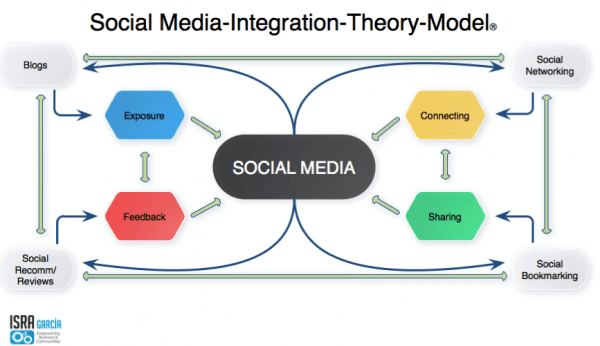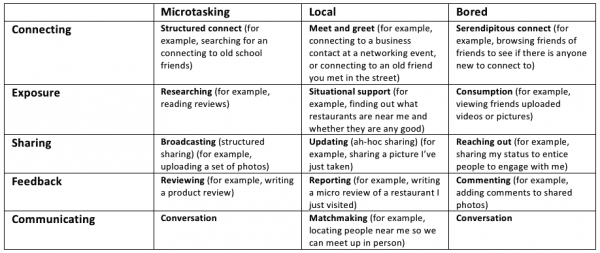Models of human interactions that help manage the convergence of social media and mobile marketing
Social and mobile are two of the largest growth areas in the technology world. It is therefore inevitable that commentators are keen to identify (and understand how to monetise) convergence between the two. There is great synergy between the two areas. Both are focused on communication, both are undeniably personal and both are very immediate.
Which new propositions can you offer though combining mobile + social?
Whilst a computer is a window onto the web and into your social connections, a mobile, be it an iPhone, iPad or Android smartphone, is your personal window. And unlike a computer it brings extra data and functionality with it. With a mobile, you can share where you are and what you’re doing, generally in a much richer way than a simple status update. This is all becoming fairly commonplace and the level of use of this type of functionality is growing inexorably. The question is, once you’ve gained access to your social network of choice through your smartphone, what is there to tempt you to do more than what effectively amount to multimedia or spatial updates?
This is the question put to business and organisations who seek to engage with users in the social mobile world. Some businesses have an easier time answering this question than others. Foursquare, for example, is a great example of a social mobile offering. Find, visit, share, rate, all a great fit for social mobile and one of the key factors behind its success (as well as the gamification). But your business isn’t Foursquare, so how do you work out where you fit in this space?
Understanding the mindsets of consumers using mobile + social
Josh Clark, a well-respected voice in the field of iPhone app design, talks about three mindsets mobile users tend to have.
- Microtasking, when a user is engaged in short periods of intensive activity.
- Local, when a user seeks information about or to support them in their current context.
- Bored, when the user is looking for distraction, novelty or entertainment.
As Josh himself has recently pointed out, these mindsets map nicely onto Google’s categorisation of mobile information usage; repetitive, urgent and bored.
Now, social mobile can fill one or all of these categories. So we need to delve a little deeper to understand what aspects of social interaction match these mindsets.
A model to help understand mobile + social interaction
When thinking about the different types of human interaction possible through social media, I found this model by Isra Garcia particularly useful for its human perspective:

From this model there are effectively four different types of interaction to be managed:
- Connecting to others.
- Exposure, viewing information and activity within your network.
- Sharing information with others.
- Providing feedback on shared information or on a specific topic.
- There is also an associated interaction that can be facilitated or initiated through social media:
- Communicating directly with others.
When combined with the mobile mindsets different types of social mobile interaction emerge. Using this, albeit simplistic abstraction, we can start to see how organisations can understand where their business and any potential mobile offering might fit.

If we return to Foursquare, or other similar proximity services, we can see that it covers the following areas:
- Researching – what’s good in my area?
- Situational support – is there anything good near me right now.
- Reporting – I’ve found something great, or I want to review this too.
- Matchmaking – are any of my network available to join me?
- Reaching out – well, what could I do today?
Which is quite a large portion of the spectrum, particularly the local part. Interestingly if we look at the social networks themselves, we can see that Facebook covers the entire spectrum (depending upon which of their suite of services you use), whereas the professional network Linkedin, is rooted firmly in the microtasking area, with some small forays in local.
So, how is this useful? There are two aspects, understanding what situation you find a user in will directly influence how you can engage with them and what the likelihood of them wanting to engage with you is. This I will cover in a future article. The other is determining which aspects of a product or service could benefit from a social aspect. A couple of examples might help to illustrate this.
1. iPad video app: I have an app that lets people insert their face over the lead character in short clips of popular films. It’s a great timewasting app, but after the initial rush of downloads, sales have stagnated. There are several aspects of social interaction we can target. Broadcasting and the flipside, consumption, would allow people to share their videos with others. If we add in reviewing, via commenting, then we cover off a neat conversion of a bored user into a microtasking (and therefore more engaged) user.
2. Customer reviews app: I have a service that helps people to view and share reviews of cars. I only focused on letting people easily view the reviews database (the researching goal). This is great, but I’m missing two other goals that would help to harness the community. If I were to provide an easy route to information about “that car there” (situational support) then I add to the utility of my app/mobile site. If I were to offer the ability to review a car (reviewing/reporting) or even ask a question (conversation) then I would increase both the utility of and engagement with my app.
Or how about a real world example, Groupon. Groupon is an offers site, with the key to their success being the sharing and viral spread of deals. Currently the Groupon mobile offering lets people find offers near them and share them with their network. This is simple, straightforward and it works. However, there are a number of ways that this could be enhanced.
What if the service were to recommend deals that my friends have looked at or taken up (consumption)? What about reviewing or rating deals (reporting)? For dinner deals in particular, how about the facility to invite other people in your network to take advantage of a deal (matchmaking). All of these could enhance the Groupon service. As I was putting this article together, Groupon and Foursquare announced that Groupon daily deals would now be available through Foursquare. This looks to be very much a win-win situation for both of these companies.
It’s important to stress that I don’t intend to advocate simply bolting social elements onto a mobile offering. The appropriateness and likely appeal of the social aspect should be carefully considered. For example it might be good to use a service to find reviews of local doctors, but you probably don’t want to connect to your doctor or share with others that you’re visiting them.
The question then becomes, how do we gauge appropriateness and appeal? A great first step is to look at what similar services are doing and the level of engagement they attain. This will provide some indication of what social features might be useful and whether people will actually use them. If you have an existing product that you’re looking to socially augment, then depending upon your budget you then have a couple of options for determining which social features would be best for your product. Surveys provide a cost effective way of building a picture of the types of features people might use. Focus groups and one to one interviews can then build upon this insight.
If you don’t have a product yet, then your silver bullet is ethnography, whereby actual user needs are collected in context over an extended period of time. This is a very powerful method for understanding a person’s interaction, not only with technology, but also their environment and the people in their lives.
As part of this process you also need to consider how social features in your mobile offering link up to the rest of your communications channels and services. If the social experience is constrained just to the mobile platform, this represents a missed opportunity to widen the reach of your service. This opens up another set of questions around consistency of experience and handling of transitions between channels.
All of the above can be considered in an ad-hoc manner, but I would strongly recommend creating a mobile strategy to guide the development of any mobile offering. When coupled with a full user centred design approach, you can ensure that your mobile service or product meets the needs of your users, delivers on your commercial priorities and offers a great user experience.

Thanks to
Bill Wessell for sharing their advice and opinions in this post. Bill Wessel is Head of Mobile User Experience at
Foviance. He helps organisations to make the most out of the possibilities provided by mobile devices to provide useful and compelling experiences for their audiences. Bill has more than a decade of experience in the UX industry and has a passion for all things technology. Bill’s other thoughts on mobile, user experience and the technology industry can be found
here. You can also
follow him on twitter.





 Thanks to
Thanks to 



